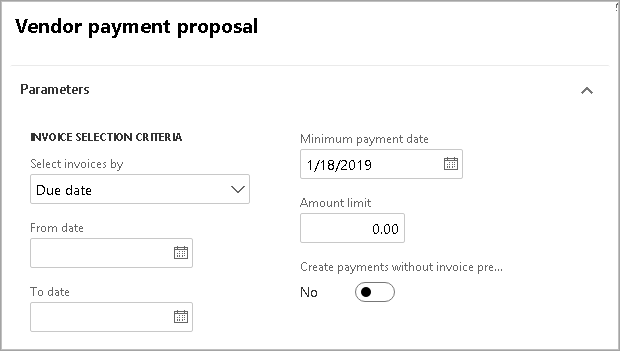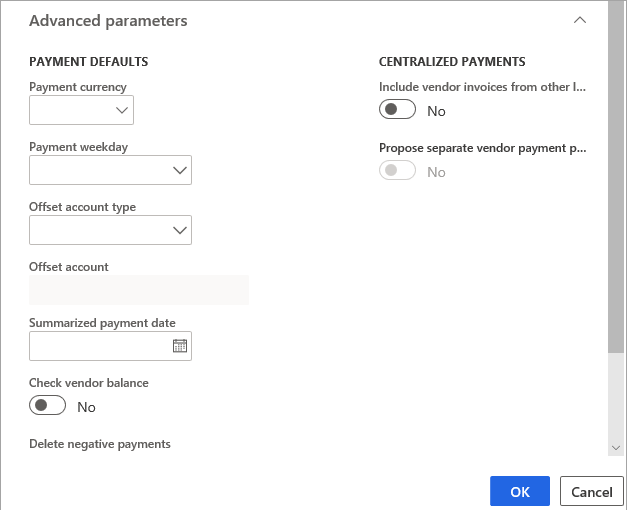Create vendor payments
This unit provides an overview of payment proposal options and includes examples that show how payment proposals work. It also covers what happens when you overpay or underpay an amount to a vendor.
Payment proposals
Frequently, you would use payment proposals to create vendor payments. The reason is because you can use the query to quickly select vendor invoices for payment based on criteria, such as the due date and cash discount.
The following video describes how to pay vendor invoices and use payment proposals.
The payment proposal query contains various tabs, each having different options for selecting invoices to pay. To access the query, go to Accounts payable > Payments > Vendor payment journal > Lines > Payment proposal.
Parameters - This tab contains options that most of the organization frequently uses.
Records to include - On this tab, you can specify which invoices or vendors to include for payment by defining ranges for various characteristics. If you want to pay only for a specific range of vendors, you can define a filter for the vendor range. Most often, you would use this functionality to select invoices for a specific method of payment.
For example, if you define a filter where Method of payment = Check, the system selects for payment only the invoices that have that payment method, as long as they also meet other specified criteria in the query.
Advanced parameters - This tab contains extra options, some of which might not be relevant to your organization.
For example, the tab contains options for paying invoices for centralized payments.
Parameters
The following parameters are on the Vendor payment proposal page:
Select invoices by - You can select invoices within the specified date range in the From date and To date fields by due date, cash discount date, or both.
If you use the cash discount date, Finance first looks for invoices that have a cash discount date between the From date and To date. Then, Finance determines whether the invoice is eligible for the cash discount by using the session date to make sure that the cash discount date hasn't already passed.
From date and To date - The system selects for payment invoices that have a due date or cash discount date within this date range.
Minimum payment date - Enter the minimum payment date.
For example, the From date and To date fields specify a range from September 1 to September 10. The minimum payment date is September 5. In this case, all invoices that have a due date from September 1 to September 5 have a payment date of September 5. However, all invoices that have a due date from September 5 to September 10 have a payment date that's equal to the due date of each invoice.
Amount limit - Enter the maximum total amount for all payments.
Create payments without invoice preview - If this option is set to Yes, the system immediately creates payments on the Vendor payments page. In this case, the system skips the Payment proposal page; therefore, it can create payments faster. You can still modify payments from the Vendor payments page, or you can return to the Payment proposal page by using the Edit invoices for select payment button.
Advanced parameters
The following overview provides a description of the Advanced parameters on the Vendor payment proposal page.
Check vendor balance - If this option is set to Yes, the system verifies that a vendor doesn't have a debit balance before it pays an invoice. If a vendor does have a debit balance, the system doesn't create a payment.
For example, the vendor might have credit memos or payments that have been posted but haven't been settled yet. In these cases, you shouldn't pay the vendor. Instead, you should settle the credit memos or payments against the outstanding invoices.
Delete negative payments - This option works differently, depending on whether you make payments for individual invoices or for the sum of invoices that meet the payment criteria. The method of payment defines this behavior.
Payment for each invoice - If the Delete negative payments option is set to Yes, and an unsettled invoice and payment exist for a vendor, the system only selects the invoice for payment. The system doesn't settle the existing payment against the invoice. If the Delete negative payments option is set to No, and an invoice and a payment aren't settled, the system selects the invoice and the payment for payment.
Payment for sum of invoices - If the Delete negative payments option is set to Yes, and an unsettled invoice and payment exist for a vendor, the system selects the unsettled invoice and the payment for payment. Then, the system adds the amounts together to produce the total payment amount. The only exception occurs if the sum results in a refund. In this case, the system doesn't select the invoice and the payment. If the Delete negative payments option is set to No, and an invoice and a payment aren't settled, the system selects the invoice and the payment for payment, and then it adds the amounts together to produce the total payment amount.
Print report only - Set this option to Yes to view the results of the payment proposal on a report, but without creating payments.
Include vendor invoices from other legal entities - If your organization has a centralized process for payment, and the payment proposal should include invoices from other legal entities that are in the search criteria, set this option to Yes.
Propose separate vendor payment per legal entity - If this option is set to Yes, the system creates a separate payment for each legal entity for each vendor. The vendor on the payment is the vendor from the invoice from each legal entity. If this option is set to No, and the same vendor has invoices in multiple legal entities, the system creates one payment for the total amount of the selected invoices. The vendor on the payment is the vendor in the current legal entity. If the vendor account doesn't exist in the current legal entity, the system uses the vendor account of the first invoice that must be paid.
Payment currency - This field specifies the currency that the system creates all payments in. If a currency isn't defined, the system pays each invoice in the currency of the invoice.
Payment weekday - Enter the day of the week to make the payment. You would only use this field if the method of payment is set up to total invoices for payment on a specific day of the week.
Offset account type and Offset account - Set these fields to define a specific account type (such as Ledger or Bank) and offset account (such as a specific bank account). The method of payment for the invoice defines the default offset account type and offset account, but you can use these fields to override the default values.
Summarized payment date - You would use this field only when the Period field on the method of payment is set to Total. If you define a date, the system creates all payments on this date and ignores the Minimum payment date field.
Additional filters - On the Records to include tab, you can define more ranges of criteria. For example, if you want to pay only a range of vendors, you can define a filter for the vendor range. You would use this functionality to select invoices for a specific method of payment. For example, if you define a filter where Method of payment = Check, the system selects for payment only the invoices that have that method of payment, as long as they also meet other specified criteria in the query.
After you create the payment proposal, the system automatically fills in the journal lines. The fields that the system fills out includes:
Main account type - The Main account type for the vendor payment journal is set by default to Vendor and you can't change it.
Offset account type - You can change the Offset account type to another account type. However, you can't set it to Vendor. An error message occurs, stating Account type Vendor is not valid for this journal type. This same principle also applies to the Customer payment journal.
Summarize transactions
To summarize transactions in the bank subledger, see Summarize vendor and customer payments in bank transactions.
Partial payment
You might make a partial payment where the amount that still needs to be settled is small. For example, the vendor invoice is for 1,000.00, and you pay 999.90. If the remaining amount is less than the specified amount for overpayments or underpayments on the Accounts payable parameters page, the system automatically posts the difference to an overpayment/underpayment ledger account.
Print payment advice
You might want to print your payments to send them to your vendors to verify the status of your vendor payments. Previously, you could only complete this task for vendor payment journals of a Sent status. However, now you can print payment advices for the Vendor payment journal that are in the Sent or Approved status.

